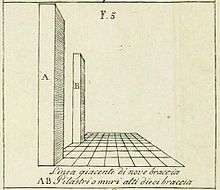De pictura



De pictura (English: "On Painting") is a treatise written by the Italian architect and art theorist Leon Battista Alberti. The first version, written in vernacular Italian in 1435 under the title Della pittura, was for a general audience. The Latin version, the De pictura of 1439–41, was more technical and intended for scholars.[1] The work is the first in a trilogy of treatises on the "Major arts" which had a widespread circulation during the Renaissance, the others being De re aedificatoria ("On Architecture", 1454) and De statua ("On Sculpture", 1462).
Context
Alberti was a member of Florentine family exiled in the 14th century, who was able to return in Florence only from 1434, in the following of the Papal court during the Council of Florence. Here he knew contemporary art innovators such as Filippo Brunelleschi, Donatello and Masaccio, with whom he shared an interest for Renaissance humanism and classical art. Alberti was the first post-classical writer to produce a work of art theory, as opposed to works about the function of religious art or art techniques, and reflected the developing Italian Renaissance art of his day.
Work
Contents
Book I: a simple introduction for young boys, in preparation for studying painting[2]
Book II: a survey of types of painting for teenage trainees in a workshop[2]
Book III: advice to the adult painter on how to perfect his skill[2]
Approach
De pictura aimed to describe systematically the figurative arts through "geometry". Alberti divided painting into three parts:
- Circumscriptio (Italian: disegno), consisting in drawing the bodies' contour
- Compositio (commensuratio in the Italian version of the treatise), including tracing the lines joining the bodies
- Receptio luminum (color), taking into consideration colors and light.
The treatise contained an analysis of all the techniques and painting theories known at the time, in this surpassing medieval works such as The book of Art by Cennino Cennini (1390). De pictura also includes the first description of linear geometric perspective around 1416; Alberti credited the discovery to Brunelleschi, and dedicated the 1435 edition to him.[3]
Alberti argued that multi-figure history painting was the noblest form of art, as being the most difficult, which required mastery of all the others, because it was a visual form of history, and because it had the greatest potential to move the viewer. He placed emphasis on the ability to depict the interactions between the figures by gesture and expression.[4][5]
De pictura relied heavily on references to art in classical literature; in fact Giotto's huge Navicella in mosaic at Old St. Peter's Basilica in Rome (now effectively lost) was the only modern (post-classical) work described in it.[6]
Influence

De pictura influenced the work of artists including Donatello, Ghiberti, Botticelli, and Ghirlandaio.[7] His treatment of perspective was the most influential of his recommendations, having a powerful effect on Leonardo da Vinci, and through him on the whole Italian renaissance.[8]
Alberti made at least 29 uses of Pliny the Elder's Natural History, deriving his key themes of simplicity and seriousness directly from Pliny. For example, Alberti advised artists to use colour with restraint, and to paint in the effect of gold rather than using actual gold in their paintings. Gold did indeed vanish from Italian paintings of the second part of the 15th century. Artists however found their own ways to paint with restraint, rather than following Alberti's actual instructions directly. Similarly, he encouraged artists to add black when modelling shapes, rather than only adding white as Cennino Cennini had advised in his c. 1390 Il Libro dell'Arte. This advice had the effect of making Italian renaissance paintings more sombre. Alberti was here perhaps following Pliny's description of the dark varnish used by Apelles.[8][9]
Bibliography
Editions
- 1435/6, Della Pittura (in the Tuscan dialect of Italian)
- 1439–41, De pictura (in Latin)
Translations and critical editions
- Spencer, J (1956, 1966) On Painting. New Haven.
- Grayson, Cecil (1972) On Painting and On Sculpture: The Latin texts of De Pictura and De Statua. Phaidon.
- Rocco, Sinisgalli (2011) On Painting. A New Translation and Critical Edition. Cambridge University Press.
References
- ↑ O'Connor, J. J.; Robertson, E. F. (January 2003). "Mathematics and art - perspective". University of St Andrews. Retrieved 21 October 2016.
- 1 2 3 Wright, D. R. Edward (1984). "Alberti's De Pictura: Its Literary Structure and Purpose". Journal of the Warburg and Courtauld Institutes. 47: 52–71. JSTOR 751438.
- ↑ Edgerton, Samuel Y. (October 2006). "Brunelleschi's mirror, Alberti's window, and Galileo's 'perspective tube'". História, Ciências, Saúde-Manguinhos. 13 (suppl. 0). doi:10.1590/S0104-59702006000500010.
- ↑ Blunt, Anthony, Artistic Theory in Italy, 1450-1660, (1985) [1940] OUP, ISBN 0-19-881050-4, pages 11–12
- ↑ Barlow, Paul, "The Death of History Painting in Nineteenth-Century Art?" PDF, Visual Culture in Britain, Volume 6, Number 1, Summer 2005, pages 1–13
- ↑ Alpers, Svetlana Leontief (July 1960). "Ekphrasis and Aesthetic Attitudes in Vasari's Lives". Journal of the Warburg and Courtauld Institutes. 23 (3/4): 190–192. JSTOR 750591.
- ↑ Lefaivre, Liane (2005). Leon Battista Alberti's Hypnerotomachia Poliphili: Re-Cognizing the Architectural Body in the Early Italian Renaissance. MIT Press. pp. 135–. ISBN 978-0-262-62195-3.
- 1 2 Ackerman, James S. (1994). Distance Points: Essays in Theory and Renaissance Art and Architecture. MIT Press. pp. 86–87. ISBN 978-0-262-51077-6.
No particular precept in the first part of De pictura had as pervasive an impact as the following section on perspective construction; the specific recommendations on color and shadow were ineffectual.. But the incalculable change that Leonardo wrought was directly dependent on Alberti's vision of art as a branch .. of optics
- ↑ Grafton, Anthony; Most, Glenn W.; Settis, Salvatore (2010). The Classical Tradition. Harvard University Press. p. 214. ISBN 978-0-674-03572-0.
